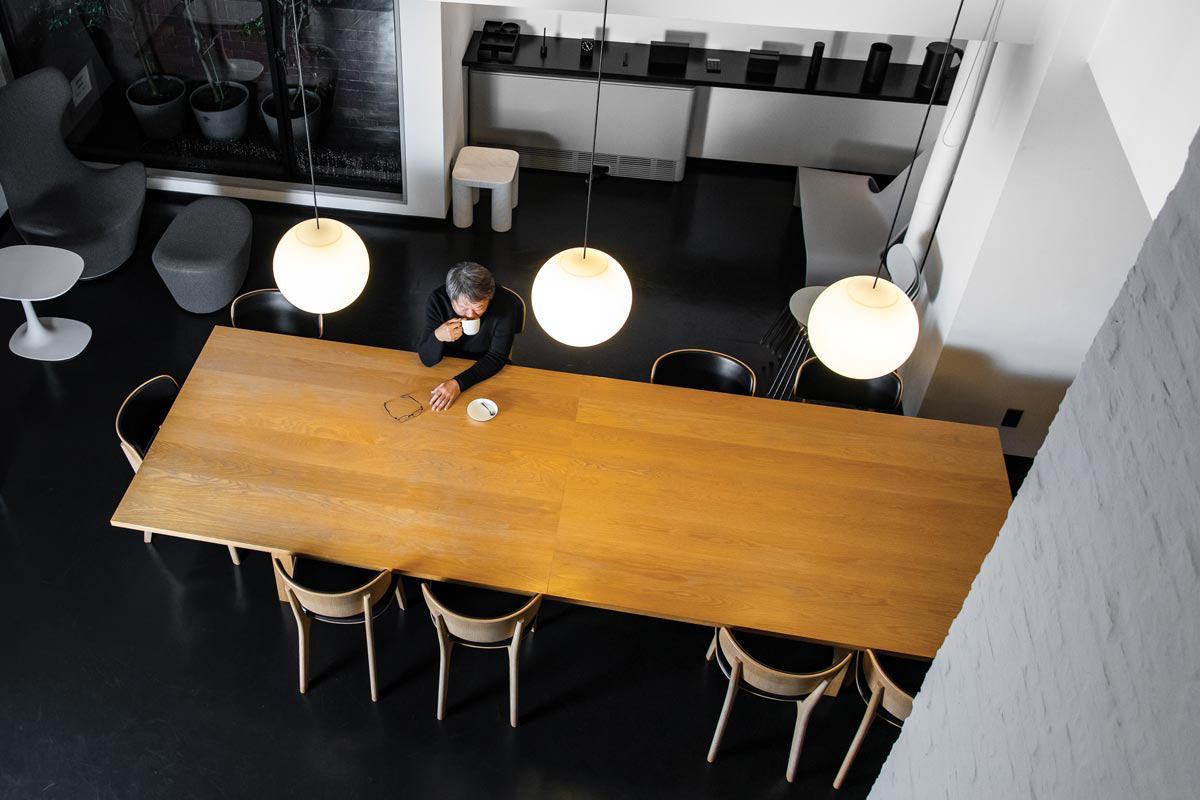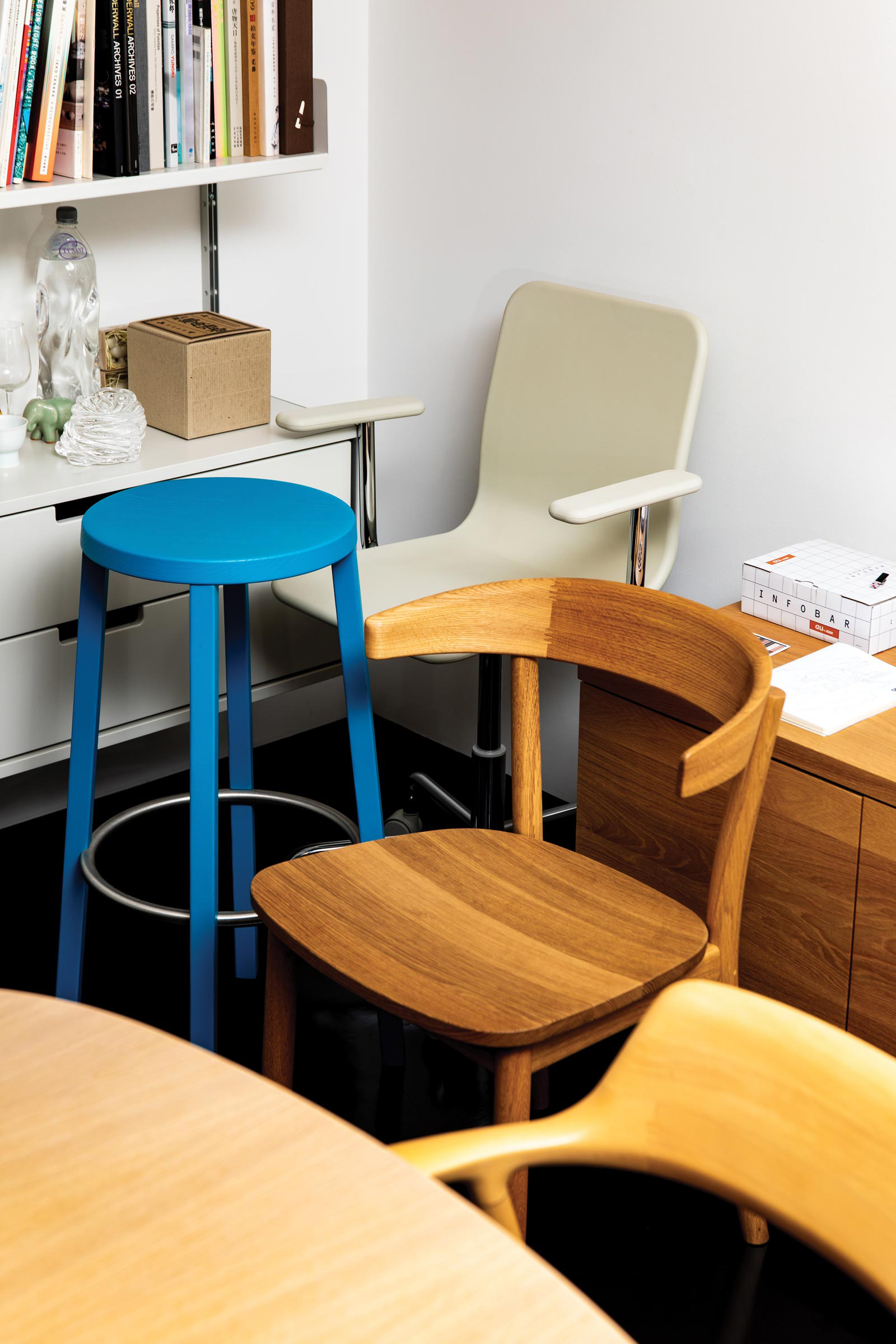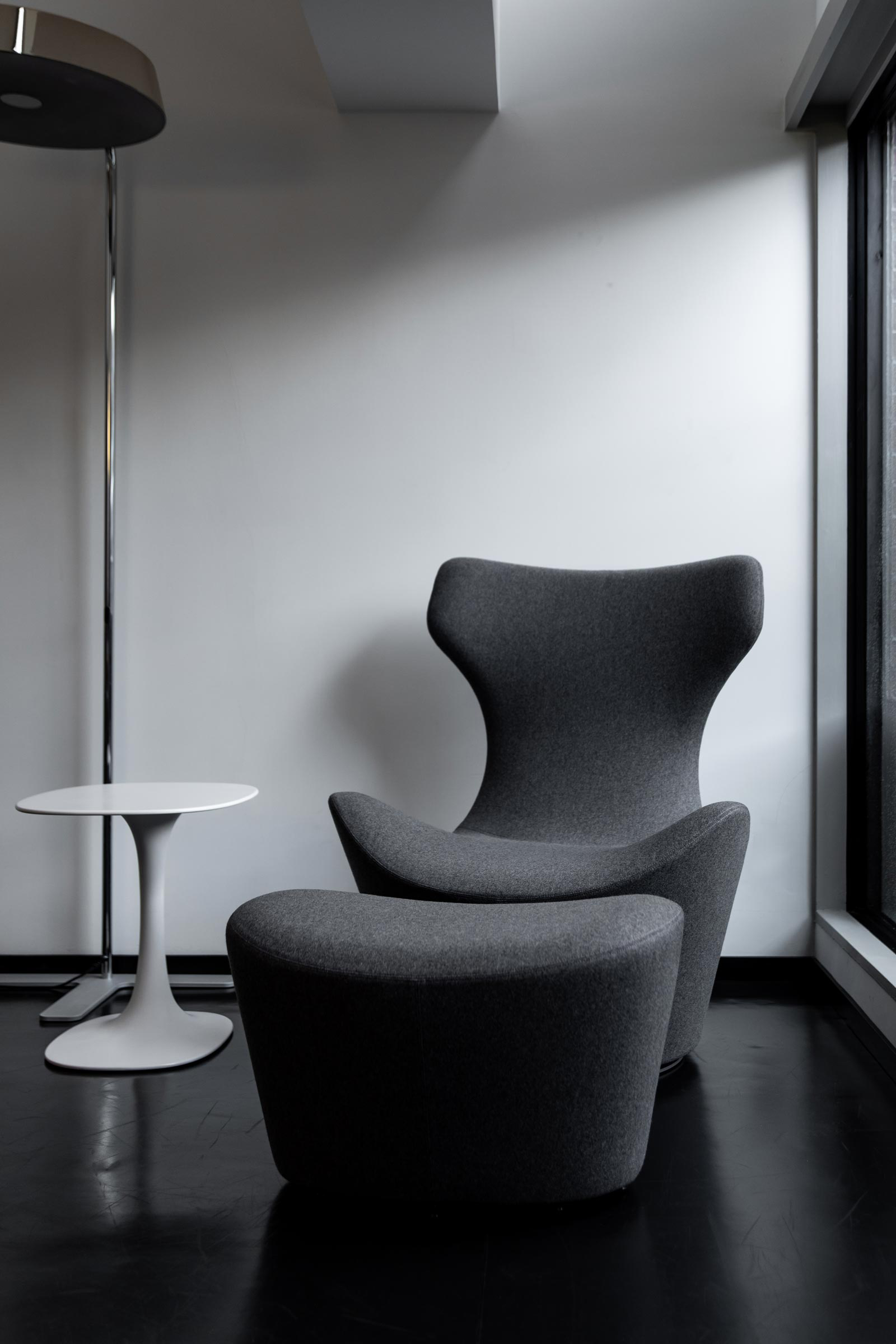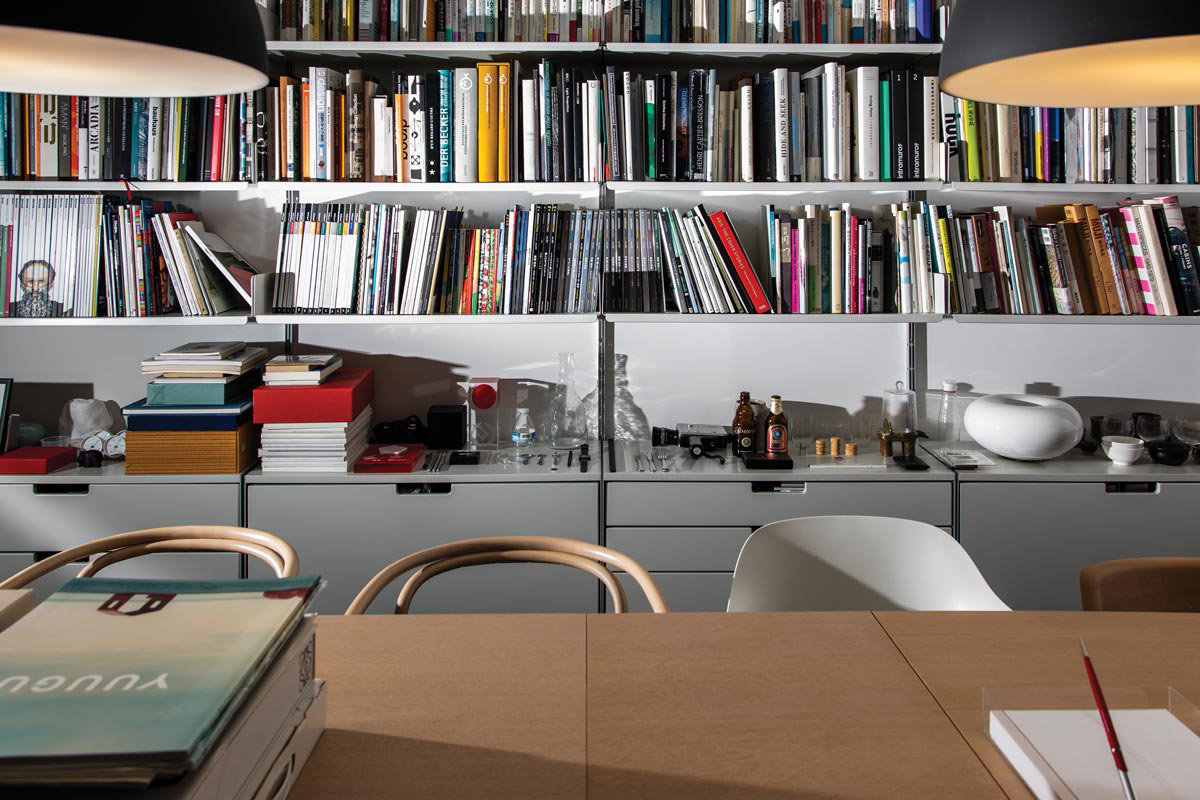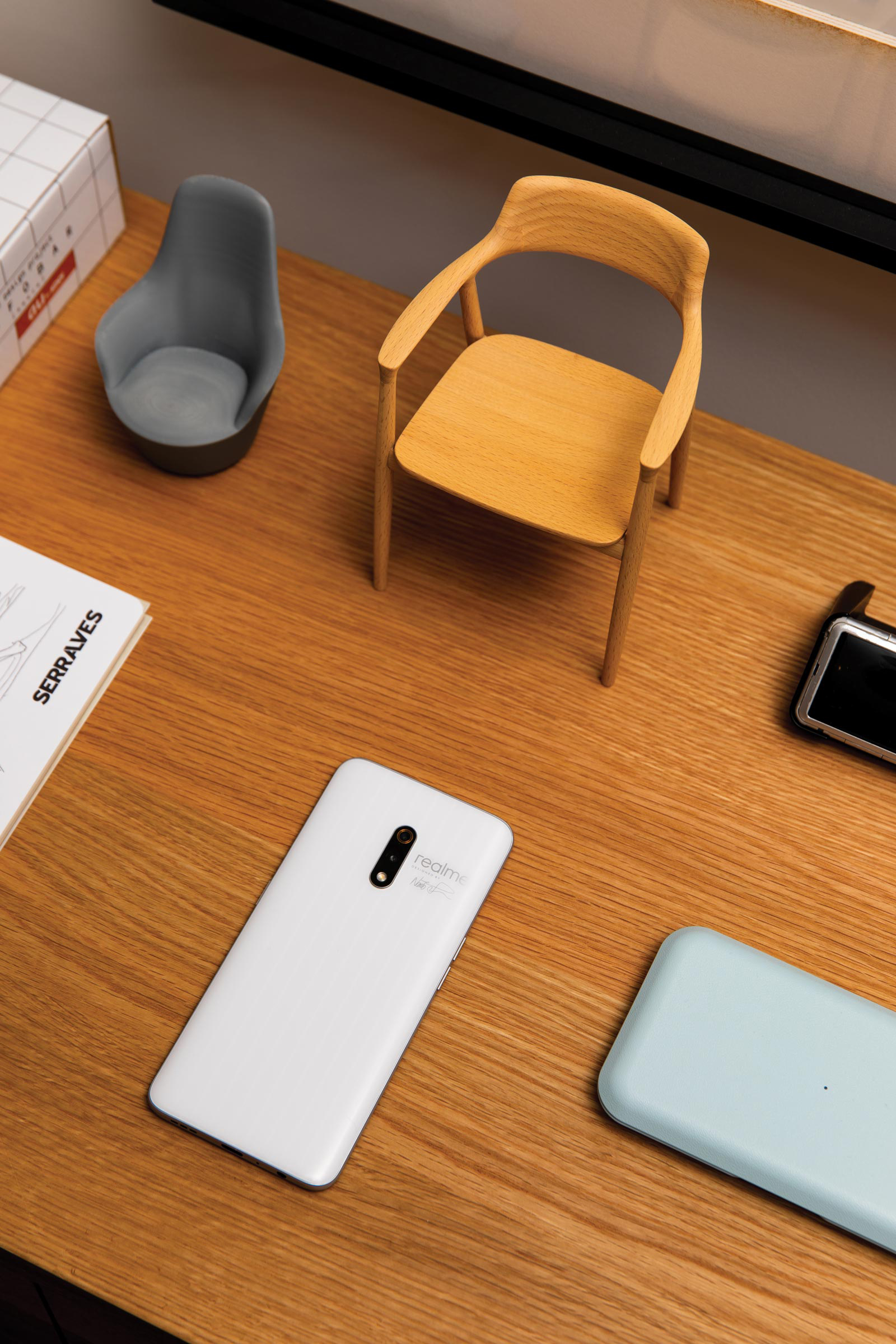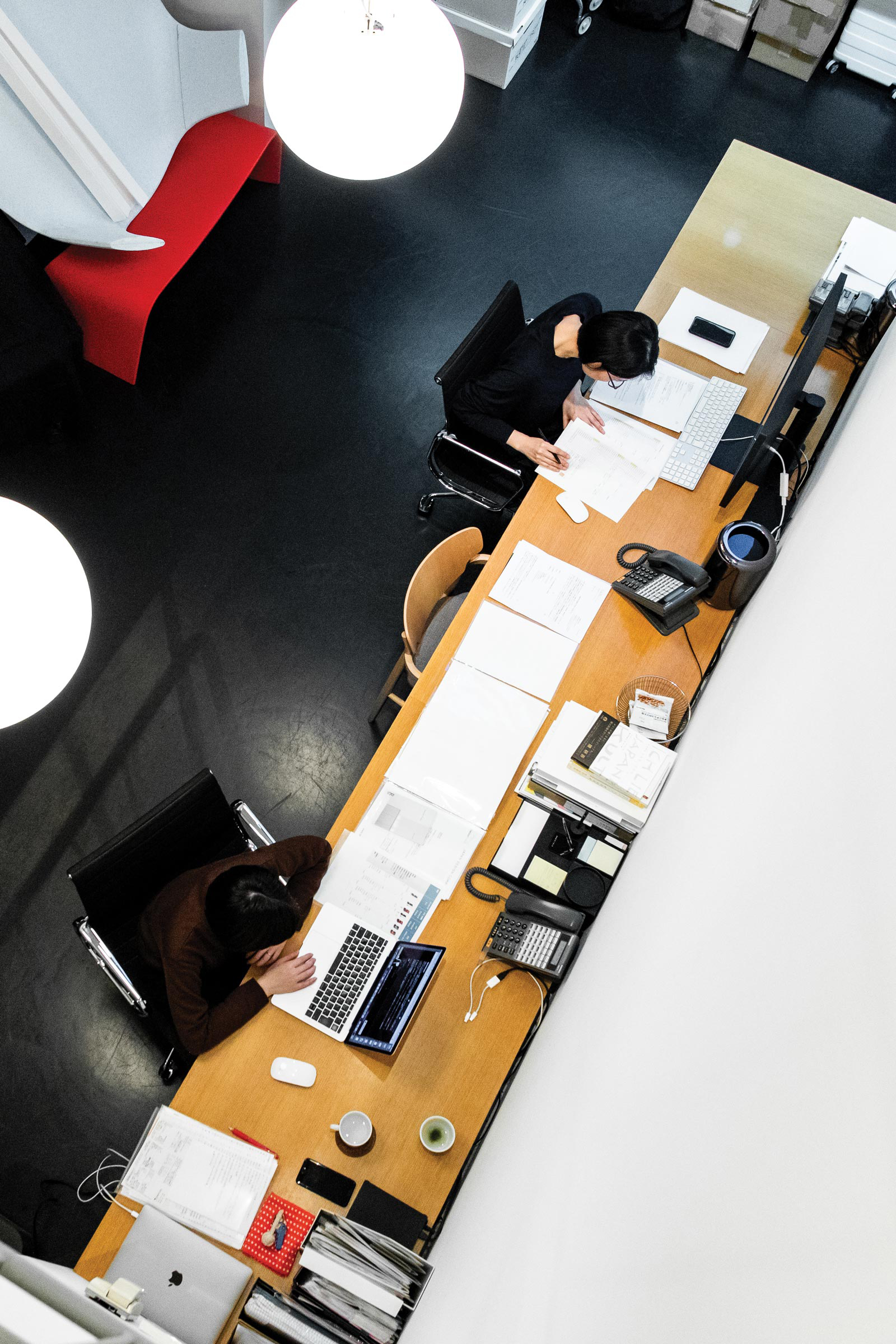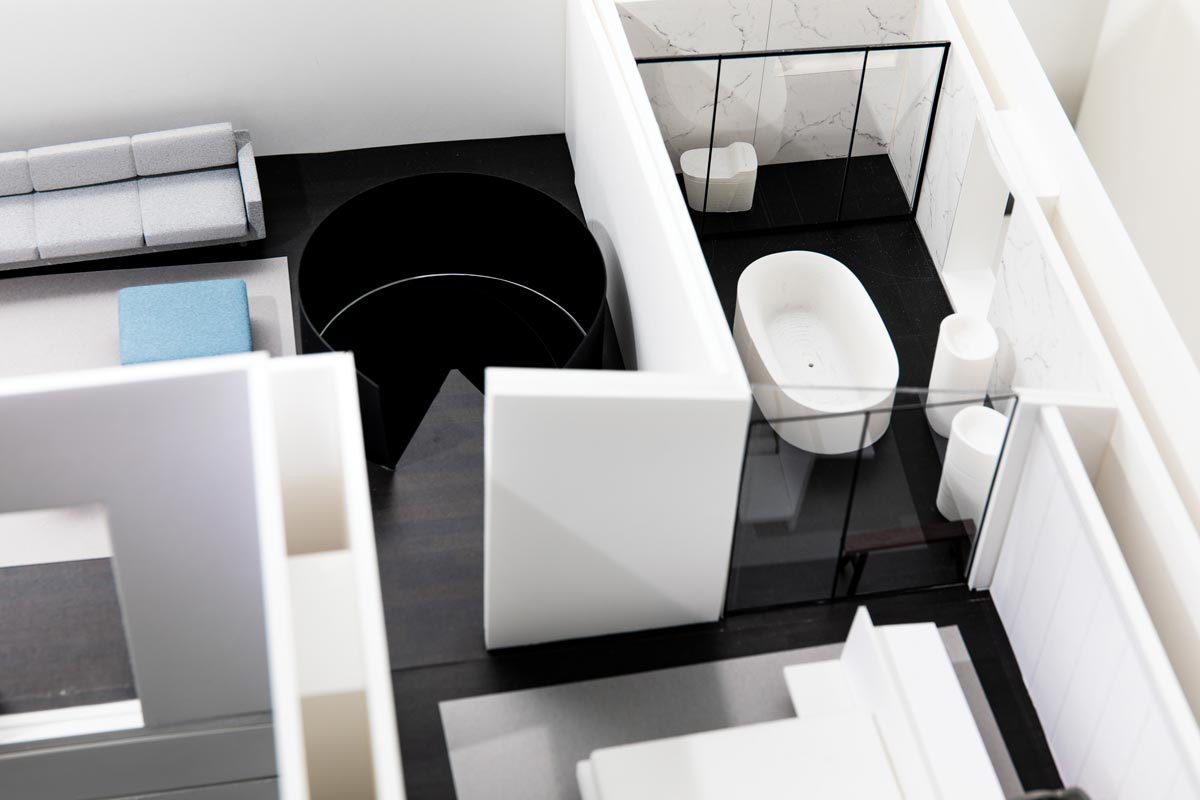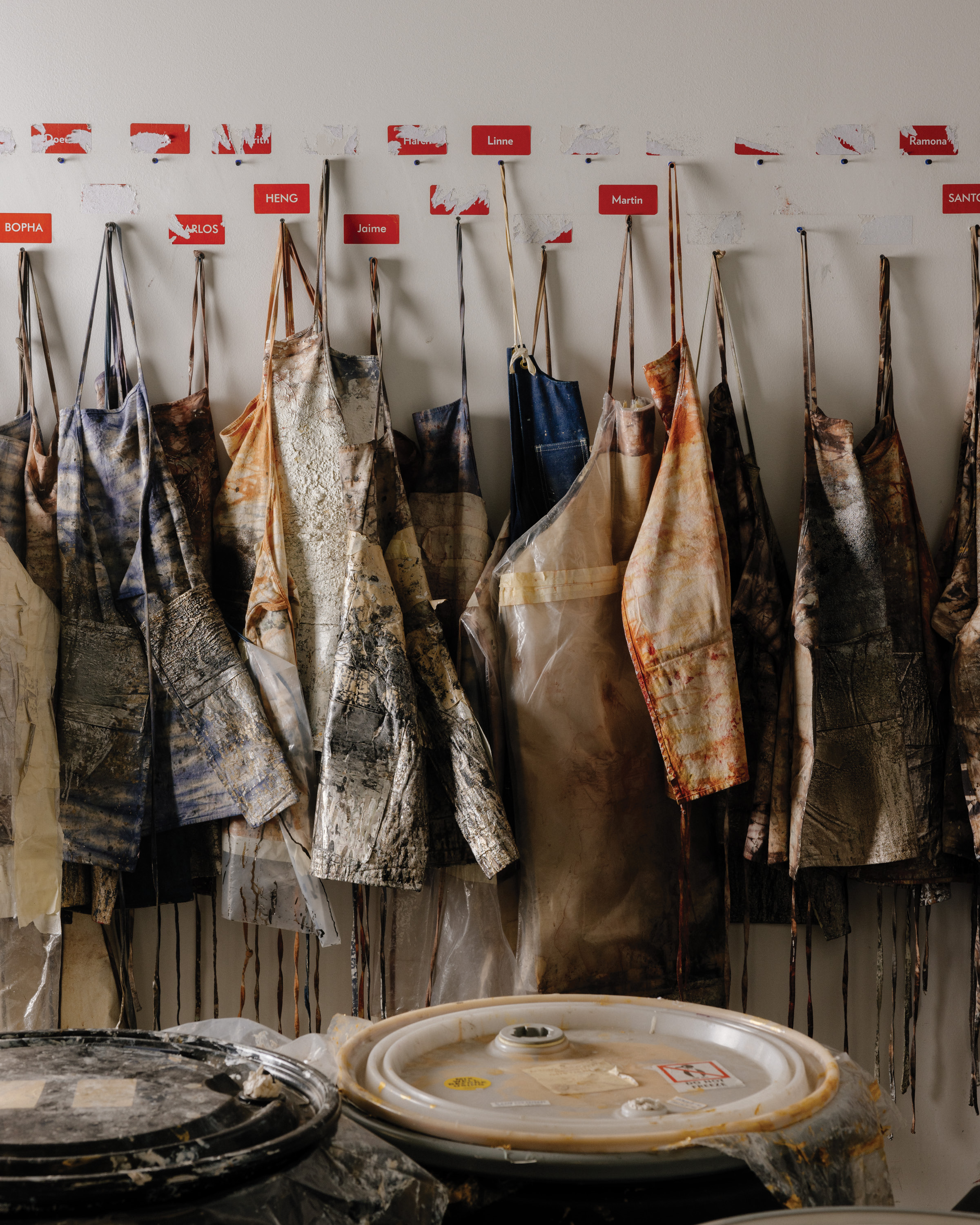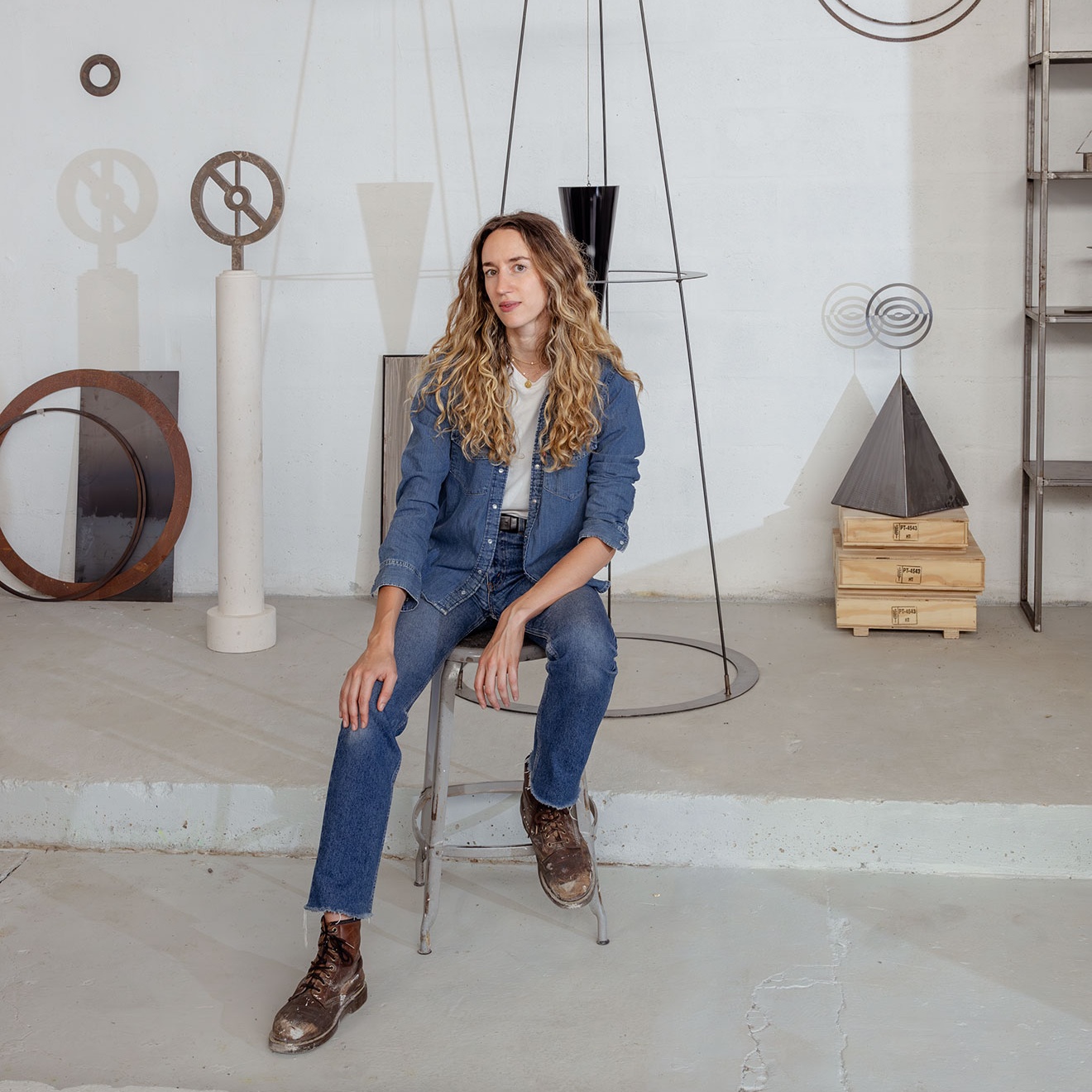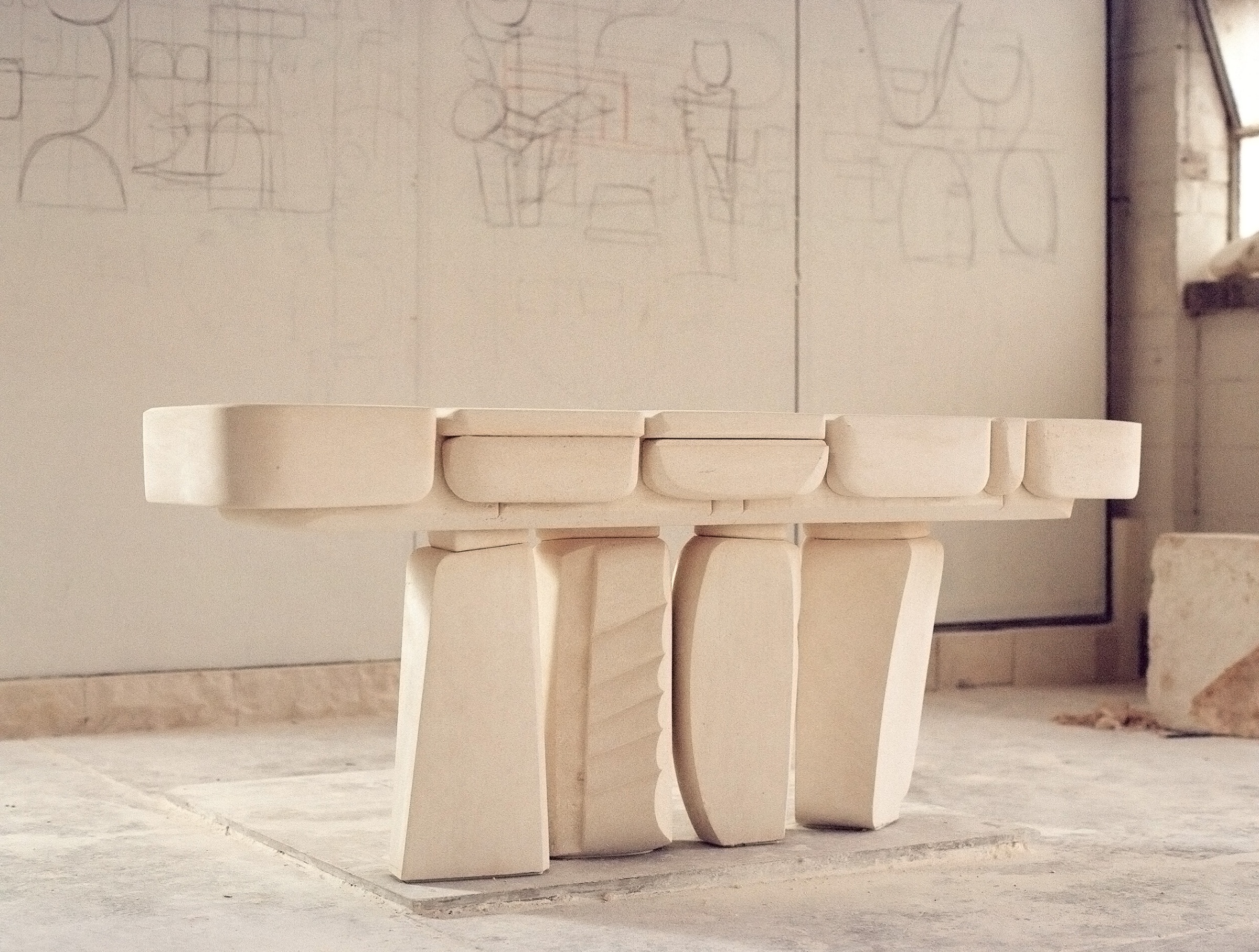The From 1st Building, complex and labyrinthine in its design, seems almost antithetical to the work of Naoto Fukasawa, whose own intuitive designs bring life to top brands all over the globe. But Naoto was drawn to the five-story, brick Deconstructivist structure for Naoto Fukasawa Design in part because of its location on one of the main thoroughfares in Tokyo’s chic Aoyama neighborhood.
Inside Naoto’s studio almost everything is black and white with few exceptions—like Naoto’s red diamond-shaped Isamu Noguchi Award. “I like black and white,” he says. “It’s simple.”
On the first level you’ll find his collection of all-black objects called “Elements of Life,” a recent commission for Alibaba. The series—which includes a clock, speaker, cups, and other household items—was designed with unobtrusive rectangular or round shapes and no switches, prioritizing harmony with the user’s environment as many of Naoto’s creations do. The office is filled with beautiful, functional examples of his work—like his Papilio chair, wall-mounted CD player, and Muji office supplies. Upstairs, employees are busy making models, first in Styrofoam and then with computer modeling. Everyone on his close-knit team of eight is involved in the prototyping process.
- A large portion of Naoto Fukasawa’s projects are furniture, though he got his start in electronics. Photo by Andrew Faulk
- Naoto wanted his Grande Papilio armchair to look natural and comfortable. It was designed with fluidity around an upside-down truncated cone. Photo by Andrew Faulk
Naoto says his office is all about flexibility, embracing new technologies, and seamlessly integrating work and life. “You should be happy, or it is difficult to design,” he says. And Naoto should know; he’s always at work. Every day he makes a trip into From 1st, though most days he’s also doing a smattering of other things, from teaching at Tama Art University to working as a director at Mingeikan, or The Japan Folk Crafts Museum. Then he has interviews to prepare for and special events to attend. But every late afternoon he’s onsite to check in with his team and get more hands-on work done. “When I’m here I send clients drawings and photos, then have discussions with staff about issues like competitors and details. Then I go back to drawing sketches with my expert designer and it evolves from there. That designer is an expert at interpreting the essence of my initial sketches. This is my way of communication.”
- “I admire projects that keep things small. Design is like a huge ship controlled by a tiny switch. Design is the power of this switch. I want to keep small, always doing the right things in design.” Photo by Andrew Faulk
Naoto spends a large amount of time traveling as well, and he keeps a small apartment in Milan so he can be close to his Italian and European clients. “I need to be there to experience their culture,” he says. While his studio is small, it’s clearly international; he has one Japanese designer based in Hong Kong and another team member in Israel. Roughly 70% of his projects are from outside Japan, with a large portion from Europe in furniture and lighting. “Japan makes up 20 or 30% of my practice, but I stay based in Japan partly because Muji is my largest client. I’ve also been on their advisory design board for almost 20 years. Muji doesn’t use designers’ names, so no one knows what my designs for them are, but it’s a huge number of designs. It’s great to be anonymous,” he says. The humble industrial designer—the same man who once designed a cell phone that looked like a peeled potato—lives by the rule that, in general, people should not choose an object based on the designer’s name. “They should focus on whether the object is good or bad. If someone sees my name as famous and chooses a design based on that, that’s not so natural.”
- Naoto Fukasawa has found inspiration in some surprising places, including a block of cement and, more recently, onions and garlic, reflected in both color and texture on realme, the Chinese smartphone. Photo by Andrew Faulk
- Naoto Fukasawa’s studio is made up of a close-knit group of eight. Photo by Andrew Faulk
Naoto’s design journey is unexpected, as he started working in electronics and as a watch designer for Seiko. Then he joined IDEO in California and learned consulting work. “After I resigned from IDEO and established my company in 2003, lots of European clients contacted me. I felt a bit strange because I used to be more technical, but they asked me to do furniture,” he says. “It was a good experience; I can design the interface for smartphones as well as design chairs.” Recently Maruni Wood Industry installed more than 4,000 of Naoto’s “Hiroshima” wooden chairs in Apple Park. “Apple is the top platform in the world, but they chose the most handcrafted wood chair for their park. I think that’s interesting.”
Now Naoto is designing his own atelier, which he describes like a house with space for people to do their best work together. “There’s a kitchen, a big dining room, bedrooms, and a basement workshop. It’s a little outside the city center, but it’s close to the studio—about a 15- or 20-minute drive.”
- Naoto Fukasawa’s studio is full of examples of his work, including small models like this one. Photo by Andrew Faulk
But Naoto is at his most creative when he gets that initial brief, or when he first visits a factory or store to experience a proposal. “By the time I send my ideas to my designers, I have a clear image of the things in my mind.” He doesn’t spend a ton of time thinking and making and then rethinking and making. “I have a very clear idea. Like GACHA [the self-driving shuttle bus I designed for MUJI]. I bring a gacha toy capsule like the ones that come out of vending machines and say, ‘How about a bus like this?’ And that’s it. They understand and ask me to do everything to realize the bus. That’s a kind of magic, but it’s our skill.”
Last year Naoto received the Isamu Noguchi Award, which chooses designers whose work “celebrates Eastern and Western exchange.” Naoto says he first discovered these intersections of culture in his work when he was 35. “Before I tried to train forms and shapes, like a sculptor. Even in Silicon Valley when I designed electronic devices, I focused on being a good sculptor or form maker. I was lucky to be in America, but I focused more on Japanese beauty. I could see Japan from outside of Japan.” That’s also when he found Isamu Noguchi—his hero. “He was a very abstract artist, but he had his own powerful, perfect aesthetic. He was half-Japanese, half-American, so he had a bridge between both cultures. I wanted to focus on sculptural beauty like he did.”
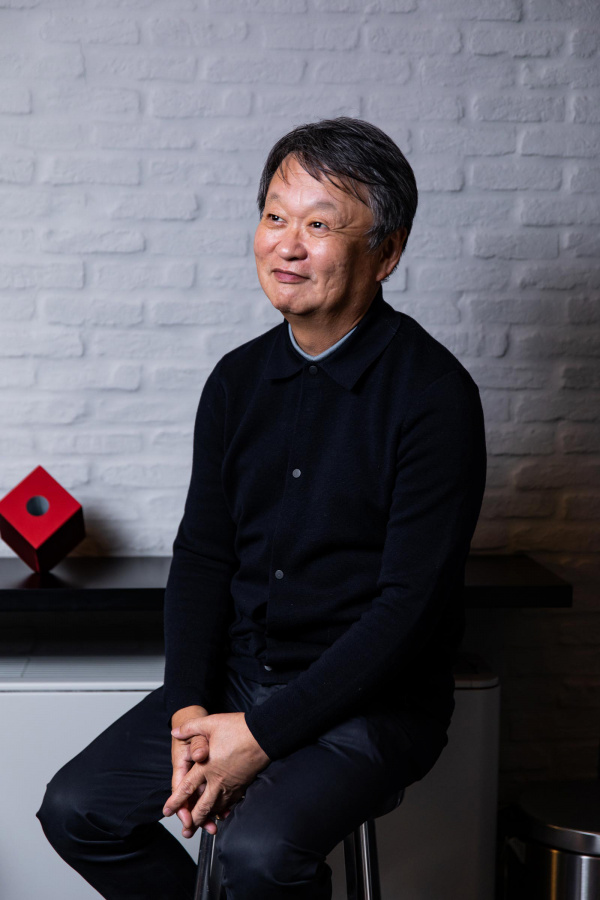
“You should be happy, or it is difficult to design,” Naoto Fukasawa says. Photo by Andrew Faulk
Naoto then strived to make his products not in a way that expressed shape, but in a way that was neutral. “I did some exhibitions and wrote a book, Super Normal, with Jasper Morrison. Noguchi was my hero, but I also believed my products should be this ‘super normal.’” He aimed for design “without thinking” and says this is a normal state for people. “Your normal, subconscious state has more understanding and feeling for the world,” he says. “That’s why I focus on the unconscious. Designers try to reach and think too much about people’s minds—trying to figure out what people like.” He says designers should focus on the fundamentals, like what you see in “Elements of Life.” “I keep everything simple,” he says. “Like haiku. You don’t say things directly. You evoke emotion. You bring out nuance. That’s the beauty of things. I make a simple square Bluetooth speaker, for example. It’s that simplicity that makes people realize a happy life.”
This article originally appeared in the Spring/Summer 2020 issue of Sixtysix with the headline “Naoto Fukasawa: Designer.” Subscribe today.
